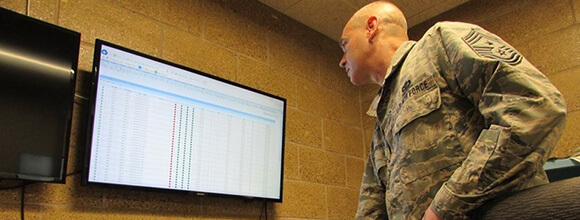Minnesota Power helps Air National Guard base exceed energy savings target
Dec 29, 2016
The 148th Fighter Wing at the Minnesota Air National Guard base in Duluth demands high performance, from its top flight personnel to its fleet of supersonic F-16 Fighting Falcons. Facilities that house the 148th and its operations are no exception. Buildings across the base are loaded with cutting-edge technologies for lighting, heating, cooling and energy management. This reflects a focused mission to reduce energy consumption and improve efficiency that dates back more than a decade.
Minnesota Power’s Power of One Business Conservation Improvement Program works hand in hand with facility and maintenance personnel at the Air National Guard base to identify potential projects, calculate energy and cost savings, and provide rebates to offset upfront costs and win approval up the ranks. Chief Master Sgt. Mark Rukavina, facility manager at the Duluth base, is a strong advocate and driving force behind many energy-efficiency improvements.
"The Minnesota Air National Guard in Duluth is what I call an engaged customer," said Chad Trebilcock, an energy efficiency analyst for Minnesota Power. "This organization is on the forefront of technology in maintaining a fleet of F-16 Fighting Falcons, and decision-makers apply the same enthusiasm for technology to facilities. For example, if they install LEDs, they also want to look at controls."
Lighting is extremely important on any military installation. The Duluth base requires round-the-clock security with well-lit roads, parking lots, walkways, entrances and interior spaces. In the past two years alone, the base has completed numerous interior and exterior lighting upgrades, replacing inefficient metal halide and fluorescent bulbs and fixtures with LEDs. The new lighting systems feature occupancy sensors and other controls that allow base personnel to match lighting levels in specific areas to actual needs.
"Our lighting control system lets us dim fixtures and program lights on schedules for greater energy efficiency," said Rukavina, noting a major project that recently replaced 1,000-watt high intensity discharge (HID), building-mounted exterior lights with LEDs and lighting controls. "We run the streetlights at 80 percent, and there is very little difference (in light quality) between that and 100 percent. (Overnight) we dim them to 40 percent, and motion sensors bring them up if they detect movement."
The Minnesota Air National Guard also has tapped Minnesota Power CIP’s expertise in light studies and lighting redesign for projects at the Duluth base rather than settling for one-to-one fixture replacement.
"With Minnesota Power’s help, we have been able to reduce the number of fixtures and actually get a better light quality in some areas," Rukavina said. "In the fire hall, for example, we are going from 90 to 30 fixtures with LEDs—that is quite a difference!"
In addition to lighting, the Air National Guard has upgraded heating, ventilation and air conditioning (HVAC) systems in multiple buildings with direct digital controls to better manage air-handling units and pumps, installed variable frequency drives on HVAC motors, and replaced multiple air conditioners with units that have energy efficiency ratio ratings higher than state code.
Energy conservation improvements completed to date in 2014–2016 have reduced or avoided electric usage at the base by 510,484 kilowatt hours per year and monthly demand by 100.7 kilowatts.
As a military installation, the Minnesota Air National Guard is required by the federal government to reduce its energy consumption every year. The Duluth base has been very successful at meeting and exceeding its goals.
"An executive order required us to reduce our energy use by 2.5 percent a year from 2005 to 2015, and we were able to accomplish that—reducing consumption by 37.5 percent over that time frame," Rukavina said. "Now there is a new one through 2025 for an additional 25 percent reduction. We’ve already gotten the low-hanging fruit, that’s why we are looking at processes and controls to further reduce energy consumption at non-peak times."
Other large, multi-facility customers of Minnesota Power face similar challenges. For the past few years, representatives from the Minnesota Air National Guard, the City of Duluth, St. Louis County and the University of Minnesota Duluth have met regularly to discuss energy-related best practices and share experiences with different technologies. Minnesota Power’s CIP team facilitates this peer working group.
"We network with each other to gain insight into what is working and what has not worked," Rukavina said. "Members hear about projects that have been completed and visit each other’s sites to get ideas."
"These folks don’t just do the bare minimum," said Tanuj Gulati, a commercial energy consultant for Minnesota Power. "The Air National Guard puts effort into energy efficiency and invests time as well as money. It is a great relationship."
Profiles of other customers helped by Minnesota Power’s Conservation Improvement Program can be found at www.mnpower.com/EnergyConservation/CustomerProfiles.
For information about how you or your business can save energy, click here.







